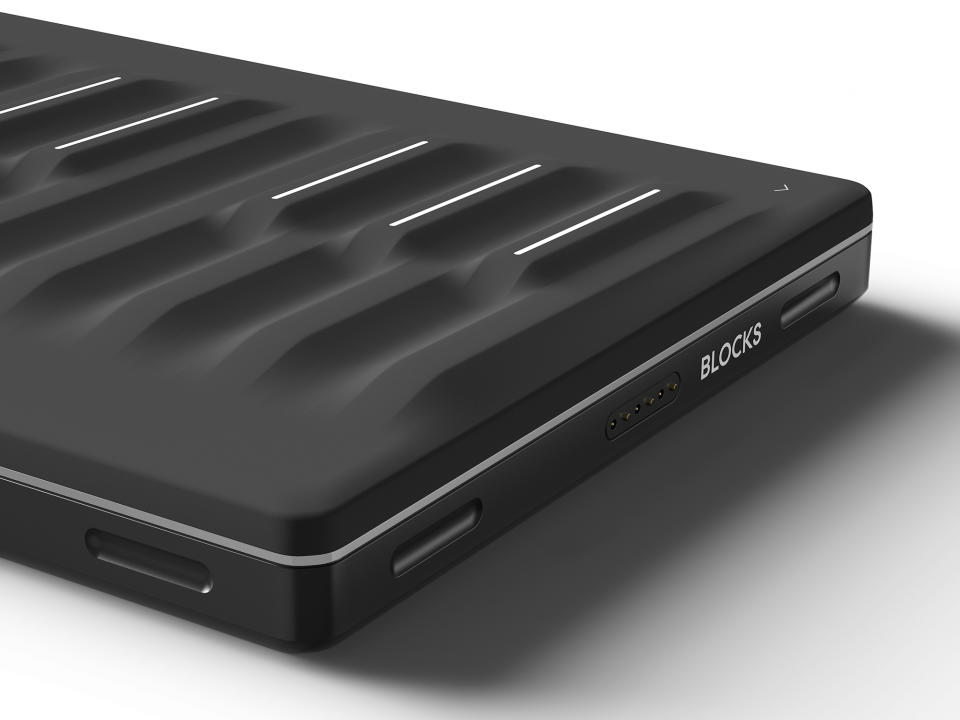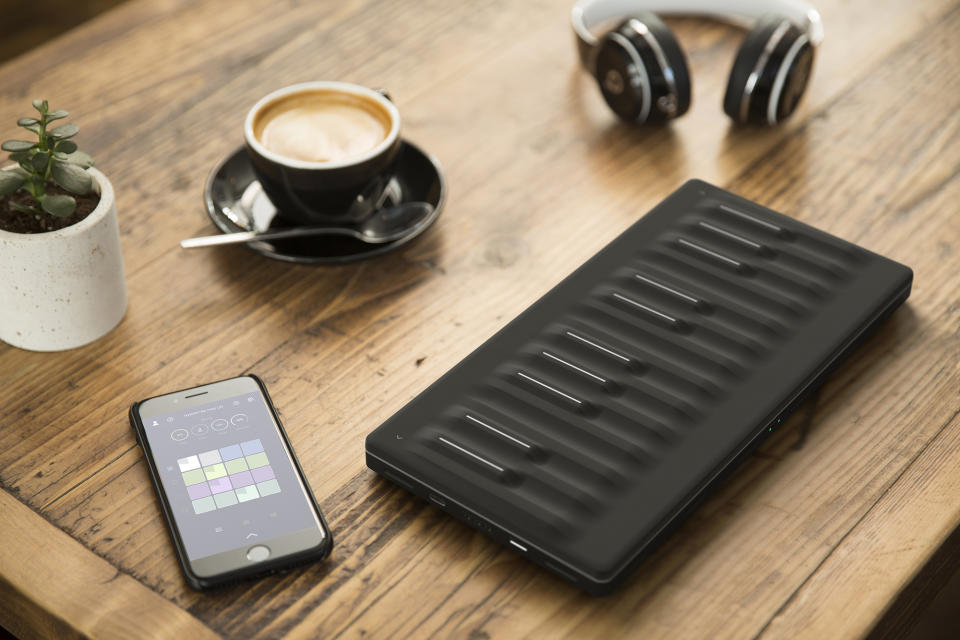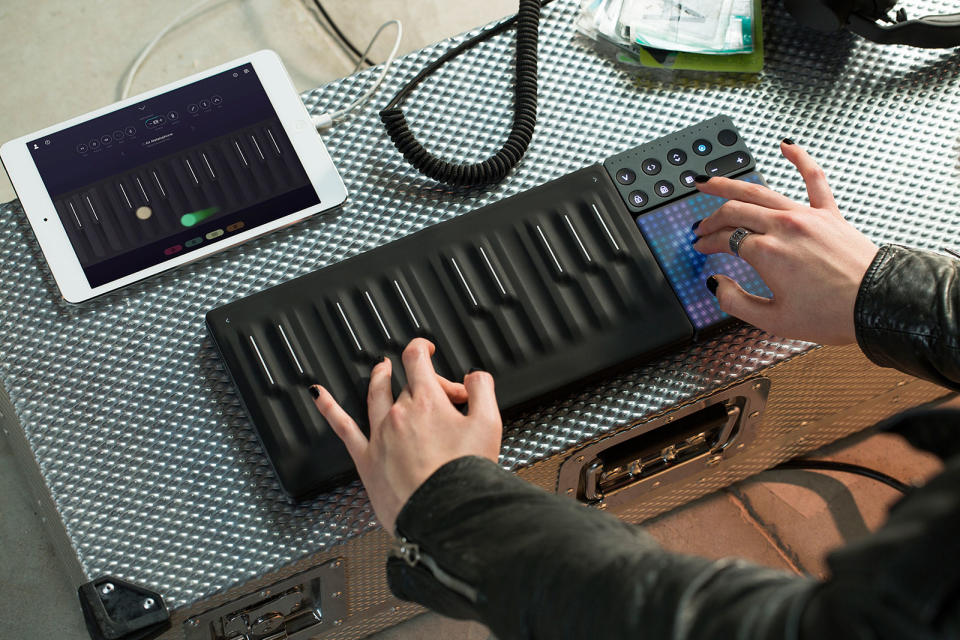Roli expands its modular music gear with the touch-friendly Seaboard
$300 will get you a two-octave Seaboard that works with your iPhone.
Last year, Roli launched an affordable, modular music creation system called Blocks. At launch, the company sold a square Lightpad block (intended for tapping out melodies and drum beats) and two smaller blocks that let you adjust a variety of settings or record and loop your music. Users can snap together as many Blocks as they want and hook them all up to an iPhone or iPad to create and record music.
I spent some time playing with Blocks earlier this year, and while there's no doubt they're a fun and unique tool, the Lightpad's small size introduced some challenges when trying to create precise compositions. Roli's looking to fix that today by taking its flagship musical instrument, the Seaboard, and shrinking it down to Block size. The new $300 Seaboard Block is a small, two-octave version of its larger Seaboard instrument, but it retains all the unique touch-sensitive features you'll find in the bigger and more expensive versions. (The Seaboard Rise starts at $800, and Roli sells a variety of other sizes that range in price from $1,110 all the way up to over $8,000.)
As such, Roli is looking at the Seaboard block as something of a bridge between the cheaper Blocks and more expensive Seaboard models -- it's both the most "premium" block Roli has created and the cheapest Seaboard by far. I got a quick demo of Roli's new Block, and it looks like it'll go a long way towards solving some of the problems I had with the company's modular music system.
Perhaps most importantly, the Seaboard is significantly bigger than the Lightpad -- it's the width of three of those blocks. That increased size means that there's far more room to play with, making it a lot easier to be more precise with what you're playing. The Seaboard's layout is reminiscent of a traditional piano, which means it's a lot better for playing melodies than drums, but you can bang out beats if you're so inclined. Just like the Lightpad, the Seaboard Block is essentially just a MIDI controller with some unique touch-sensitive features.

If you haven't played a Seaboard before, it differs from a traditional piano in a number of ways. For starters, the keys form a continuous surface, so when you play a note, you can just hold your finger and slide up and down the board for smooth transitions between notes -- it's a lot like a fretless bass. The surface is also pressure-sensitive, so notes will ring out stronger the harder your attack. Once you're holding a note, you can also apply more pressure to increase the intensity of the note.
Sliding your fingers vertically up and down the Seaboard's surface will apply various modulation effects, and you can also slide horizontally across the Seaboard's surface to change tones -- there's even a completely flat strip at the bottom of the keyboard that makes gliding left and right easier than dragging your fingers across the key bumps. Finally, the keyboard also recognizes how quickly you remove your fingers from the surface and cuts off the notes accordingly -- removing your hand quickly cuts the note right off, or you can slowly ease your fingers off to let the sound ring out longer.
This all adds up to an extremely versatile and unique playing surface -- one that was the inspiration for the touch- and pressure-sensitive Lightpad block. But the vastly increased surface area means that users have much greater control over each individual note. I often felt like I was "running out of room" when using the Lightpad; that's not a feeling most users should have to worry about with the Seaboard.

Roli's also releasing a new $79 "touch" block specifically for the Seaboard that lets you control the keyboard's sensitivity without needing to dig into an app's menus. It's half the size of the Lightpad, like Roli's existing Loop and Live blocks and basically provides easily accessible hardware controls that keep users from digging through menus to adjust settings.
All told you can hook all five of Roli's blocks together, in any quantity you choose -- and since they're really just MIDI controllers, you can set them up any way you want using your music software of choice. Originally, the Blocks family was designed with Roli's NOISE app for iOS in mind, but since then they've opened them up to work with additional software, including Garageband and professional-grade apps like Ableton Live and Logic Pro.
From my perspective, using a Seaboard for melodies alongside a Lightpad to serve as a drum machine seems like a pretty solid setup, though I'll need to really test it out more to see how it works in practice. But between this new hardware and software improvements Roli has made since launching Blocks last fall, the system feels much more robust than it did at launch. There's certainly still a learning curve, but Roli said that it's been updating software to address issues like I had when I tried Blocks out earlier in the year. A combination of a more responsive Lightpad Block and the new Seaboard Block might be enough to help Roli's platform take off.












